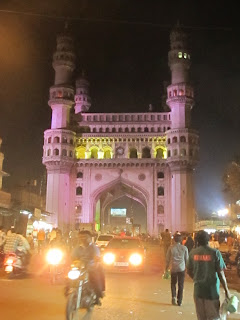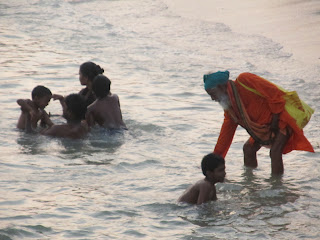I have a feeling I might not have been getting the best out of Kolkata. Having arrived here, for 2 days only, after a month of travelling the entire length of India, spending over 80 hours on trains, 30 hours on buses, staying in 11 different places, I am, quite frankly, bushed. It’s really hot here, and on our first day ended up getting in a taxi with a really aggressive driver who shouted at us because he went the wrong way and was somewhat irked that we refused to pay him the fare for both the wrong and the right destinations. On the second day, I caught someone looking through the gaps in our bathroom window, spying on me, mostly naked, after a rather uncomfortable bowel movement. I was not best pleased. Neither was Alex. I quickly got dressed and went to find the peeping Tom. Unfortunately all I had seen was a little brown head ducking out of sight, so there was no way I was able to identify the little pervert, and was compelled to complain loudly and firmly at all the members of hotel staff that were in the area in which the incident had occurred. I got upset with the manager, the staff, the receptionist, the bus boys, everyone. Yet no one wanted to help me.
I explained that I had a right to privacy and it was unacceptable for someone to spy on me. I explained that had I been an Indian woman, this would have been an abhorrent act, I tried to provoke empathy by asking if they would like their sisters or daughters to be treated in such a way. I got told by various different levels of lackey and management that I must have ‘been mistaken – Indian men are too small to see in the window’, that I could move room, and pay extra money for guaranteed privacy, that they were ‘sorry’. Again I was amazed at the total apathy and unwillingness to help, all they wanted was to make sure we stayed another night to keep the money rolling from our pockets, never mind my decency or level of personal comfort at staying in the place, or identifying the degenerate who wanted to get a sneaky peek at my breasts.
Now, had I been in the UK, or many other places, I probably wouldn’t have bothered making a fuss at all. I don’t mind that much about someone getting their jollies out of being a bit of a perv. But this is India. And I am getting sick of the misogyny and assumption that because I am white, I am a whore, and my body is not mine. Men here have felt it their right to grab my breasts and my butt, I have been propositioned by endless arseholes who demand to know my room number, been told that I will ‘enjoy’ or ‘go full power, 24 hour, no shower’ for a bit of ‘Indian magic’, been checked out with uncomfortably lusty eyes every time I walk down the street. I read in the paper that Indian women are gang raped in taxis and are told that they were out too late, so deserve what has happened. Men refuse to talk to me when Alex is around, who gets engaged in conversation that isn’t about fucking, because I am a stupid woman. I find the daily disrespect I encounter, merely because I am a woman, and a filthy white woman at that, really frustrating. I don’t want to give unbalanced impressions of a country of more than 500 million men. Many I have met are not like this, many have spoken to me as an equal and with respect, and friendliness. But I can’t deny there are a lot who do not, and I have explained in previous blogs that I understand why a little.
So bearing all this in mind, I found my principles (they were looking a little wrinkled in the bottom of my backpack) and told the hotel staff that I wanted to call the police to report the incident. And in saying those words – please will you call the police for me, I understood the fear and power that threat instils in Indian people. It was incredible. I could see in faces that there was more than fear, there was sadness. Sadness because they knew what would happen if the police turned up. All of the men that were in the area of the bathroom window, which were around 6, would have been beaten until someone confessed, and then beaten some more. Of course I wasn’t really going to call the police, but I was so pissed at the disinterest at the incident, and I didn’t quite realise the power of the threat, that I offered it. Within 15 minutes the managing director of the hotel group was with us, explaining that we could stay for no extra cost, that the perpetrator would be found and sacked and that he was very, very sorry. I told him it was wasn’t about the money, that I was fed up of being treated like a whore in this country. He explained the brutality of the police, what tourists don’t see. I just wanted an apology from the person who peeped, for them to realise that I was a human being, and was worthy of respect. If I got that I wouldn’t call the police, and that would be all I required, no sacking, no free rooms, nothing, but an apology.
Sure enough, within 2 minutes two boys were dragged into the office. One of them absolutely bricking it. They had been grassed up by those wanting to avoid the police. I was quite sad to see it was such a young man, maybe 17 years old. His friend was told to leave. The boy, who spoke very little English, tried to say it was an accident, and that he hadn’t meant to stand up on a crate to look in the window. Then the poor sod confessed. The MD, obviously peeved that he had been lied to, jumped up, yelled at the cowering young man, and then belted him with the full force of his palm across the face. That is not what I wanted. I jumped up to defend the boy I had got dragged in there, hugged him and pulled him out of the fury of the MD. I repeated that all I wanted was an apology, no violence, no sacking, just an apology. The MD sat back down, and told the boy to touch my feet and call me mother (a sign of respect Indians give to elders.) He said sorry and then was told to go. And he did, he ran from that room. I asked the MD not to sack him, and to tell the
boy that I forgave him, that there was no further problem. I hope it was listened to. Although the MD told me that I was in India now, and they had their ways of dealing with things. I also got the distinct feeling that the violence wasn’t to protect my honour, but because the MD has been disrespected by the lie. Society is very hierarchical here, and everyone must know their place within it.
Now I don’t know if I did the right thing. I just wanted an apology, for him to sit face to face with me and recognise that I was as human as he was. But instead he was shown violence and fear.
Some people have said that I did the right thing, that he may well have grown into one of those men that think its ok leap on white girls in Goa, without invitation, to try and have sex with them. Or any one of the hundreds of other examples I could give from stories I have heard about the interactions between Western women and Indian men. Now he might think differently.
I don’t think so. He was just given more fear. Not an understanding in real respect. But then is it right to let people treat others in this way without repercussion or consequence? I guess this is a country of extremes, where discipline and policing are not done with any degree of moderation or recriminations are in proportion to the act. Which means that unless I want people beaten for their misdemeanours, I let them get away with it. That seems a little fucked to me.
Anyway, Kolkata. Not really what I expected – quelle suprise. Wide, clean streets, filled with yellow ambassador cabs. The showy offerings of Greco-Roman architecture offered by the East India Company, and then the British to impress the supplicating natives. Busy, noisy, as ever. Really good Begali cuisine. Lovely parks, green, well-tended, and offering space for young lovers to ‘heavy pet’ in the bushes, which is pretty weird. There is the Victoria memorial, which, to be fair, is impressive. We attended a light and sound show there, which we thought would be a lively show splashing colourful lights over the cool white marble of the huge building. But instead it was a film in Bengali, showed on a cinema screen set up in the park in front of the memorial. I think it was very informative about the history of Kolkata, but I can’t be too sure. There were a couple if illuminations in the building, but I couldn’t infer their relevance to the story I couldn’t understand. We should have waited for the English version.
Off on another train journey today. To Darjeeling. Hopefully I will feel a little more enamoured with India. We have had a bit of a falling out. I know I love her, but at the moment, she is really pressing my freaking buttons.




















